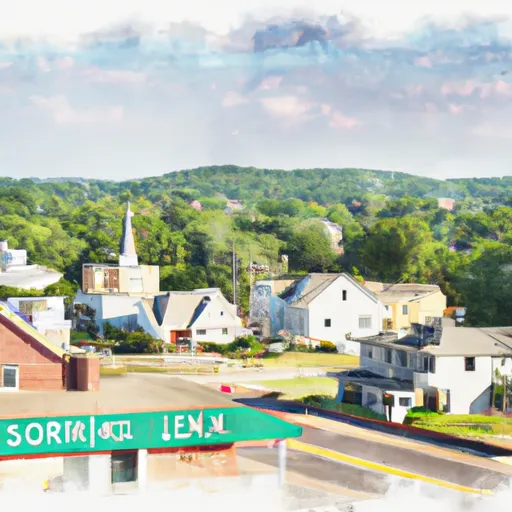-
 Snoflo Premium
Snoflo Premium
Get unlimited access to all our content
With no Ad interruptions! - Start Your Free Trial Login with existing account
Sulphur-Rock
Eden Index
Climate
8.0
•
Recreation
2.4
•
Community
0.5
•
Safeguard
4.2/10

Sulphur-Rock, Arkansas is a small town located in the northeastern part of the state. The climate in this area is classified as humid subtropical, with hot, humid summers and mild, but occasionally cold, winters. Summers are characterized by temperatures reaching the upper 80s to lower 90s Fahrenheit, while winters typically see temperatures ranging from the upper 20s to the mid-40s Fahrenheit.
Hydrologically, Sulphur-Rock is situated near the White River, which is a major waterway in the region. The river is known for its diverse aquatic flora and fauna, providing ample opportunities for fishing, boating, and other water-based activities. Additionally, the area surrounding Sulphur-Rock is dotted with numerous small creeks and streams, contributing to the town's overall hydrology.
For outdoor enthusiasts, Sulphur-Rock offers various recreational opportunities. The town is surrounded by picturesque natural landscapes, making it an ideal destination for hiking, camping, and wildlife viewing. The nearby White River provides excellent fishing opportunities, especially for anglers seeking trout, bass, and catfish. Additionally, the region offers opportunities for hunting, bird watching, and exploring the nearby Ozark National Forest, which is renowned for its scenic beauty and diverse wildlife.
Overall, Sulphur-Rock, Arkansas offers a pleasant climate, abundant hydrological resources, and a range of outdoor activities, making it an attractive destination for nature lovers and outdoor enthusiasts.
What is the Eden Index?
The Snoflo Eden Index serves as a comprehensive rating system for regions, evaluating their desirability through a holistic assessment of climate health, outdoor recreation opportunities, and natural disaster risk, acknowledging the profound impact of these factors on livability and well-being.
Climate Health Indicator (CHI): 8.0
Sulphur-Rock receives approximately
1231mm of rain per year,
with humidity levels near 81%
and air temperatures averaging around
16°C.
Sulphur-Rock has a plant hardyness factor of
7, meaning
plants and agriculture in this region tend to thrive during the non-winter months.
By considering the ideal temperature range, reliable water supplies, clean air, and stable seasonal rain or snowpacks, the Climate Health Indicator (CHI) underscores the significance of a healthy climate as the foundation for quality living.
A healthy climate is paramount for ensuring a high quality of life and livability in a region, fostering both physical well-being and environmental harmony. This can be characterized by ideal temperatures, reliable access to water supplies, clean air, and consistent seasonal rain or snowpacks.
Weather Forecast
Streamflow Conditions
Upper White
Area Rivers
Upper White
Snowpack Depths
Upper White
Reservoir Storage Capacity
Upper White
Groundwater Levels
Recreational Opportunity Index (ROI): 2.4
The Recreational Opportunity Index (ROI) recognizes the value of outdoor recreational options, such as parks, hiking trails, camping sites, and fishing spots, while acknowledging that climate plays a pivotal role in ensuring the comfort and consistency of these experiences.
Access to outdoor recreational opportunities, encompassing activities such as parks, hiking, camping, and fishing, is crucial for overall well-being, and the climate plays a pivotal role in enabling and enhancing these experiences, ensuring that individuals can engage in nature-based activities comfortably and consistently.
Camping Areas
| Campground | Campsites | Reservations | Toilets | Showers | Elevation |
|---|---|---|---|---|---|
| Notrebes Bend | None | 160 ft | |||
| Pendleton Bend | None | 172 ft | |||
| Poverty Point Reservoir State Park | 50 | 97 ft | |||
| Riverfront RV Park | None | 178 ft | |||
| Oak Grove City Park | 30 | 117 ft | |||
| Kemper Williams Parish Park | None | 5 ft | |||
| Lake Fausse Pointe State Park | None | 5 ft | |||
| Greer Crossing | 72 | 564 ft | |||
| Wilbur D Mills | None | 188 ft | |||
| Merrisach Lake Park - Merrisach Lake | None | 169 ft |
Nearby Ski Areas
Catastrophe Safeguard Index (CSI):
The Catastrophe Safeguard Index (CSI) recognizes that natural disaster risk, encompassing floods, fires, hurricanes, and tornadoes, can drastically affect safety and the overall appeal of an area.
The level of natural disaster risk in a region significantly affects safety and the overall livability, with climate change amplifying these risks by potentially increasing the frequency and intensity of events like floods, fires, hurricanes, and tornadoes, thereby posing substantial challenges to community resilience and well-being.
Community Resilience Indicator (CRI): 0.5
The Community Resilience Indicator (CRI) recognizes that education, healthcare, and socioeconomics are crucial to the well-being of a region. The CRI acknowledges the profound impact of these elements on residents' overall quality of life. By evaluating educational resources, healthcare accessibility, and economic inclusivity, the index captures the essential aspects that contribute to a thriving community, fostering resident satisfaction, equity, and social cohesion.

